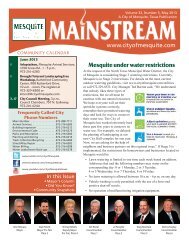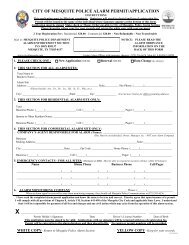airport/documents/Mesquite Master Plan Final.pdf - The City of ...
airport/documents/Mesquite Master Plan Final.pdf - The City of ...
airport/documents/Mesquite Master Plan Final.pdf - The City of ...
You also want an ePaper? Increase the reach of your titles
YUMPU automatically turns print PDFs into web optimized ePapers that Google loves.
Forecast future demand at <strong>Mesquite</strong><br />
Metro Airport indicated that the <strong>airport</strong><br />
should strive to accommodate the<br />
majority <strong>of</strong> business jet operations up to<br />
and including those in <strong>airport</strong> reference<br />
code (ARC) D-II. As presented in<br />
Chapter Three - Facility Requirements,<br />
many business jets such as the<br />
Challengers, Hawkers, Westwinds,<br />
Astras, and some Learjets have<br />
occasions when up to 7,000 feet are<br />
needed. Thus, alternative analysis will<br />
consider the possibility <strong>of</strong> extending<br />
Runway 17-35 to provide at least 7,000<br />
feet <strong>of</strong> operational length. While this<br />
length may not be fully capable <strong>of</strong><br />
accommodating all aircraft needs<br />
throughout the year, it will be more<br />
than adequate for most aircraft<br />
operations.<br />
Alternative analysis will be developed<br />
with specific attention paid to the<br />
reasonableness <strong>of</strong> implementation, both<br />
from a cost perspective as well as a<br />
feasibility perspective.<br />
TAXIWAYS<br />
<strong>The</strong> taxiway system at an <strong>airport</strong><br />
consists <strong>of</strong> all aircraft transport<br />
surfaces, excluding the runway. It is<br />
typically designated with a yellow<br />
centerline for the movement <strong>of</strong> aircraft<br />
to and from the runways. Taxiways are<br />
the primary transport surfaces linked<br />
with the runway and its operation.<br />
Such surfaces would include a parallel<br />
taxiway, entrance/exit taxiways, and<br />
connecting taxiways.<br />
Taxilanes are those surfaces that would<br />
typically realize a lower level <strong>of</strong> aircraft<br />
4-6<br />
activity because the taxilanes provide<br />
direct ingress/egress to a specific<br />
location or <strong>airport</strong> facility. An example<br />
<strong>of</strong> a taxilane would be the surface which<br />
links to a T-hangar complex. Not all<br />
aircraft will use that surface, only those<br />
going to and from the T-hangars.<br />
FAA Advisory Circular (AC) 150/5300-<br />
13, Airport Design, Change 8, provides<br />
standards for taxiway object free areas<br />
(OFAs) surrounding the taxiway<br />
system. <strong>The</strong> taxiway OFA is based on<br />
the critical aircraft design group which<br />
will frequent that particular taxiway.<br />
Design standards for Airplane Design<br />
Group (ADG) II, aircraft with<br />
wingspans from 49 feet to 79 feet,<br />
require the taxiway OFA to be 131 feet<br />
wide. Aircraft within ADG III, with<br />
wingspans from 79 feet to 118 feet,<br />
require a 186-foot-wide taxiway OFA.<br />
<strong>The</strong> taxilane OFA required for ADG II<br />
aircraft is 115 feet wide, whereas it<br />
increases to 162 feet wide for ADG III<br />
aircraft. Analysis <strong>of</strong> the existing and<br />
future taxiway OFA will be provided in<br />
the airside alternatives to follow.<br />
<strong>The</strong> current layout <strong>of</strong> the taxiway<br />
system at <strong>Mesquite</strong> Metro Airport is<br />
adequate from a functional perspective.<br />
<strong>The</strong>re are six entrance/exit taxiways to<br />
the runway and there is a terminal area<br />
taxiway that improves circulation<br />
among landside facilities. All <strong>of</strong> the<br />
taxiways are 40 feet wide except for the<br />
terminal area taxiway, which is 30 feet<br />
wide. FAA design criteria call for<br />
taxiways serving a critical aircraft in<br />
ADG II to be at least 35 feet wide. For<br />
aircraft in ADG III, the taxiway width<br />
minimum is 50 feet.




